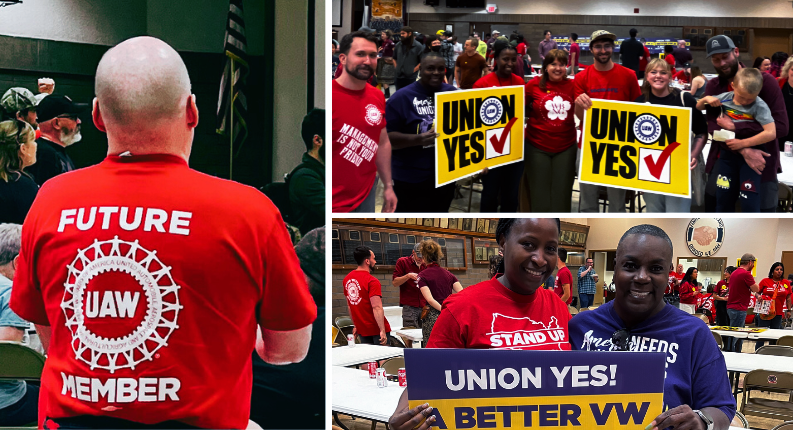Many businesses understand the value unions bring to their bottom line: increased productivity, improved service, lower turnover, higher sales, job training, and community reinvestment. As lawmakers ponder ways to improve the economy and create jobs, strengthening workers’ rights to form unions must be considered as an effective way to invigorate businesses and ready the workforce for the 21st century economy.
Businesses reap economic benefits through labor-management partnerships
Studies show that the world’s best performing economies have high union density and a high level of cooperation between labor and business.1 Partnerships among many U.S. companies, their employees, and unions have resulted in key business improvements:
- Kaiser Permanente’s labor-management partnership has trained employees as “agents for change” since 1997,2 leading to higher patient satisfaction, lower costs, reduced patient wait times, dramatic decreases in employee absenteeism, and improved employee retention.3The HMO and its employees’ unions have collaborated to improve efficiency and patient services-resulting in an increase in intake of new patients in Oakland, CA, from 73 to 97%,4and a decrease of no-shows from 12 to 4% in another facility by adopting a new confirmation policy.5
- Montefiore Medical Center’s labor-management partnership has facilitated extensive support for training programs that improve health services and hospital profits. A coordinated effort by employees’ unions and the NYC hospital turned around a problem-ridden nutrition department, increasing patient satisfaction by more than 46% and cafeteria revenue by more than 14%.6
Employers with union workers have lower turnover and higher productivity7
Workplaces with union representation have lower employee turnover rates than those without unions-a clear business advantage that results in lower training costs and a more experienced workforce.8 This lower turnover rate for union workers explains much of why unions are associated with higher productivity.9 Unions raise productivity by 16% in hospitals, between 19 and 24% in manufacturing, and between 17 and 38% in the construction sector.10
- Alabama Power has one of the lowest turnover rates in the electric utility industry-a benefit the company attributes to its relationship with its employees and their union.11 “We are extremely fortunate to have a positive, collaborative, and productive relationship with union leadership,” says President and CEO Charles McCrary.
- Brightside Academy is one of the largest providers of early childcare education services for low-income families in Pennsylvania. Turnover at Brightside decreased 20% within a year of employees negotiating a union contract that provided for training and pay increases.12
Partnerships with unions can help businesses survive
Though anti-union critics claim that unions harm a business’s bottom line, a 2004 statistical analysis of firm solvency shows no tangible effect on a business’ survival when employees form unions.13 In fact, workers and their unions are heavily invested in the success and survival of their company, and a strong partnership creates the trust and cooperation needed to help financially-trouble companies survive:
- North Philadelphia Health System’s longstanding cooperative relationship with its workers’ unions later helped rescue the company, as the unions rallied secure funding and political support to prevent the closure of its many healthcare facilities.14 “If we didn’t work together, the organization would not exist,” says James A. Gloner, Senior Vice President for Management Systems at NPHS.
- Team Industries was able to survive bankruptcy when workers bought the Wisconsin-based pipe manufacturing company in 1987. The now-thriving company services major clients like Bechtel, BP Amoco, and Conoco Phillips, thanks in part to the training its workers’ union provides.15
Unions help revitalize local economies through community partnerships16
- In response to the decline of the steel industry in Western Pennsylvania, steelworkers, faith leaders, and mayors created the Steel Valley Authority (SVA) to provide business and manufacturing investment, retention, and development services. The group advises companies on how to become more productive and energy-efficient, offers training to workers, and pursues community redevelopment projects including converting contaminated brownfields into useable manufacturing sites. Since its inception, the SVA has helped create or save at least 10,000 manufacturing jobs.17
- The Wisconsin Regional Training Partnership (WRTP) is a workforce development alliance between businesses and unions that benefits around 65,000 workers at more than 100 workplaces, mostly unionized. Since 1992, the partnership has created 6,000 jobs in the Milwaukee region and helped match 1,300 disadvantaged workers with jobs that provide them with increased benefits and more than twice their previous income.18
- In 2008, the Ella Baker Center of Oakland, CA, partnered with the International Brotherhood of Electrical Workers to secure city funding to train 40 disadvantaged youth to install solar panels and weatherize buildings.19
Unions provide higher quality services to American consumers
- Unionized registered nurses who have a say in workplace issues are better able to care for patients. In California, heart attack mortality for patients of unionized RNs was found to be 5.5% lower than for patients with non-union RNs.20
- A Cornell University study of customer service call centers found that higher pay, greater employee participation, and stronger training programs, such as those provided by unions, corresponded to higher sales growth.21






